High concentrations impact feed acceptance, feed transformation and innate immune defenses
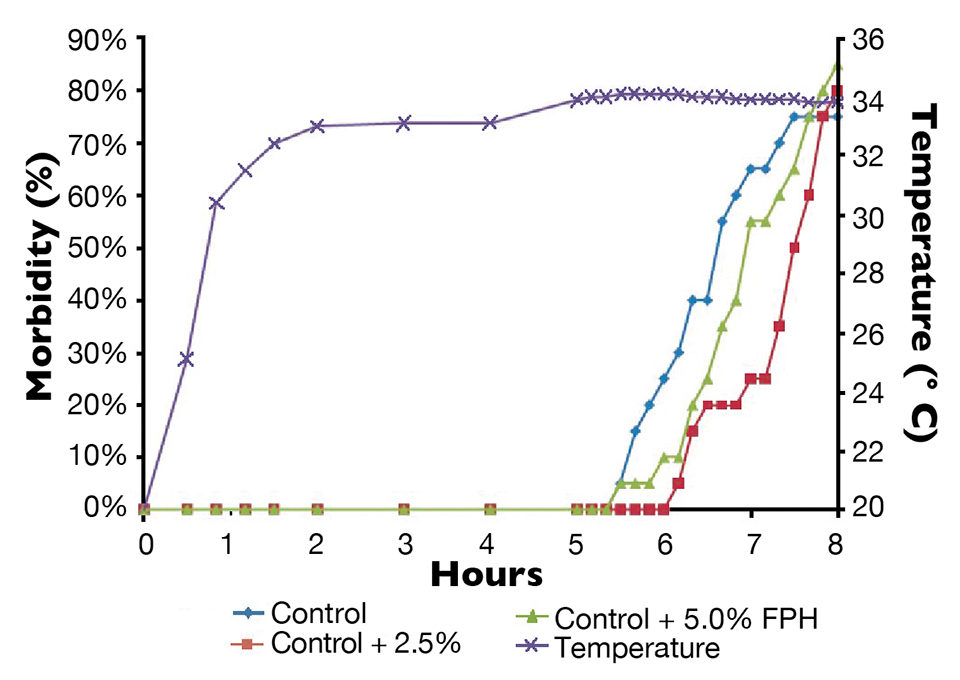
Improvement of husbandry practices is an effective approach to reduce stressful events and their effects on growth rate and mortality in aquacultured species. Beside husbandry practices, nutritional supplementation is another way to fine-tune the immune and antioxidative defenses of aquatic species. In this context, nutrients like free amino acids and derivatives, nucleotides and antioxidants are often supplemented as immunostimulators, especially during critical periods such as weaning, wintering or transfer.
When produced under highly controlled conditions, protein hydrolysates, and especially those of marine origin like fish protein hydrolysates (FPHs), are naturally rich in these nutrients. Furthermore, numerous studies have demonstrated they are rich in bioactive peptides of nutraceutic interests, such as growth-like hormone, antioxidants, and antistress and antimicrobial peptides.
Temperature stress
Temperature and salinity variations are the most important climatic issues in aquaculture. While cold weather usually impairs feed intake and growth, it usually has less adverse effects than warm weather on aquatic species’ health.
A temperature challenge trial was implemented at the end of a feeding trial on juvenile European seabass (Dicentrarchus labrax) with a mean weight of 16.3 g. Fish were fed isoproteic supplemented diets – a control, control plus 2.5 percent FPH and control plus 5 percent FPH – for 29 days in triplicate flow-through 100-L tanks.
At the end of the feeding trial, 10 fish out 40 initial fish were replaced in their respective tanks for the thermal challenge. The 33-35 degrees-C temperature range had previously been determined as lethal, so temperature was increased from 20 to 33 degrees-C within two hours without any observed morbidity.
As shown in Fig. 1, morbidity started at 34 degrees-C after five hours of challenge. The thermal challenge was stopped two hours later, when 80 percent morbidity was observed. FPH supplementation did not reduce final morbidity, but significantly delayed it (P < 0.01). This delay was especially visible in the last hour and a half of the challenge and did not seem to be dose-dependent.
Without any metabolite clues, we can only assume that FPH delayed the physiological process responsible for fish morbidity, possibly thanks to hormone-like and/or antistress effects. This trial may find commercial applications for preventive feed supplementation before the summer season, especially for flow-through or cage-farming systems.
Water quality deterioration
Through intensification, average water quality is often close to the limits tolerated by aquatic species for optimal growth. Any perturbation of water quality resulting from overfeeding, overcrowding, water renewal shortage or algae blooming can have critical consequences on the health and growth of farmed species.
Two ammonia challenge trials were implemented on juvenile tra catfish (Pangasius hypophthalmus) and Nile tilapia )Oreochromis niloticus) with a mean weight of 13 grams to assess the impact of FPHs on overall survival rates. The fish were fed for 10 weeks with commercial diets formulated with different levels of fishmeal and supplemented or not with 1.8 percent FPH in tilapia diets and 3.0 percent FPH in catfish diets.
After those feeding periods, 10 tilapia and 20 catfish were placed in aquariums for an ammonia challenge consisting of a constant 150-ppm total ammonia nitrogen load for 48 hours with 100 percent daily water exchange. Survival results are illustrated in Figs. 2 and 3. Both fish protein hydrolysates had positive impacts on survival to the high ammonia load in fish that received feeds with or without fishmeal.
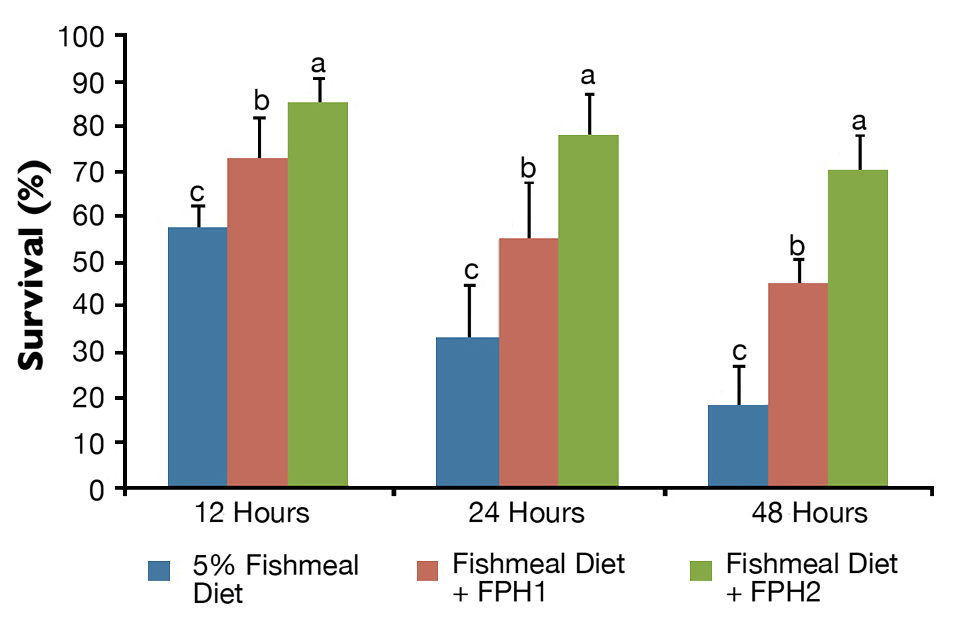
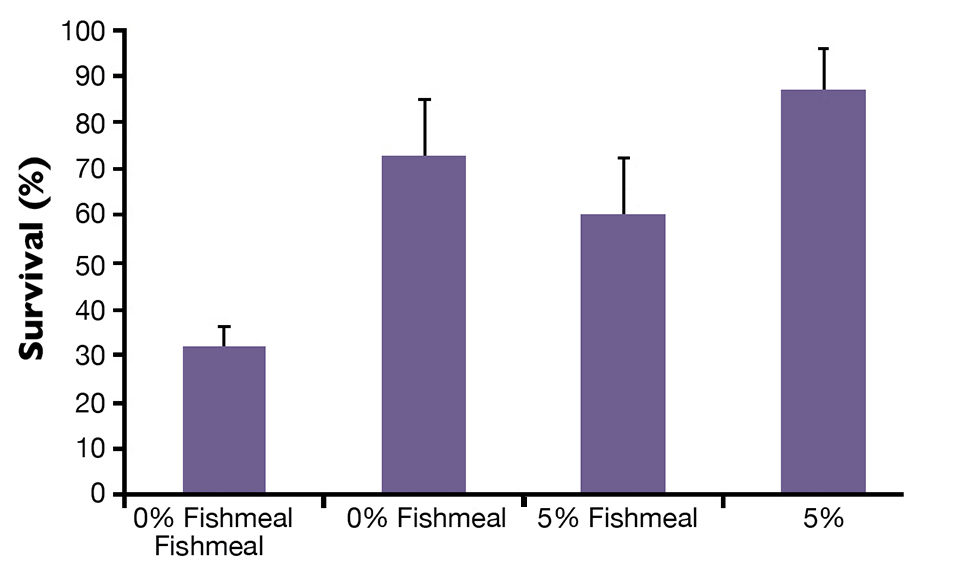
As the end product of protein metabolism, ammonia is the most common toxicant in culture and live-transportation systems. More toxic in its un-ionized form, it easily diffuses across the gill membranes of fish, reducing the outward flux of ammonia excretion. As a result, ammonia levels in fish plasma increase and cause various physiological responses similar to anoxia symptoms, finally leading to neurotoxicity and fish death in serious cases.
Several studies implemented on fish protein hydrolysates have demonstrated their biochemical functionalities, including potent antioxidative properties. Thus, it is possible to increase animals’ own antioxidative defenses thanks to FPH supplementation and, as a consequence, reduce the adverse effects of excessive production of reactive oxygen species from anoxia-like stresses induced by chemical and physical disturbances.
Feed intake, growth
It is a common practice to supplement aquatic feed with palatability enhancers during critical and stressful periods such as spawning, weaning, wintering and oral antibiotic treatments.
In a study, protein hydrolysate was formulated to meet such needs and serve as an internal reference for assessing newly developed FPHs. A total of 28 short-term feeding trials of 13 to 21days length were implemented with this internal reference, coated at 2 percent dosage on a nutritionally balanced plant-based feed, within experimental facilities named C or D.
These facilities, which consisted of two rows of 24, 100-L tanks supplied with thermoregulated and filtered seawater, only differed by their tank heights. Fish in the C tanks, which were lower, were more exposed to technicians’ work and visual contacts.
Based on the significant differences observed for average zootechnical performance indicators (Figure 4), this visual disturbance stress obviously impacted fish behavior. The growth of fish reared in C facilities was only 67 percent of the average potential growth observed for the D facilities.
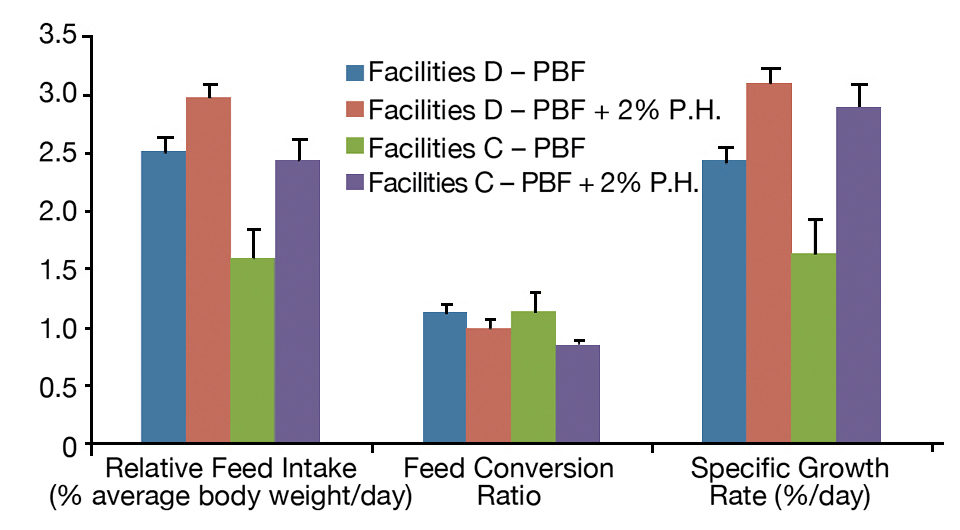
This growth retardation can be largely explained by much lower feed intake, which may entirely be solved by protein hydrolysate supplementation. In addition, through protein hydrolysate supplementation, growth rate was improved by almost 20 percent due to an average 10 percent combined improvement in feed conversion.
This benefit combination resulted, on average, in a 28 percent growth rate improvement under normal conditions and almost 80 percent growth rate increase under visual disturbance conditions. At this macroscopic scale, the improvement in feed conversion probably reflected a reduction of the gut inflammation induced by the plant-based feed and/or an optimization of gut flora. The higher feed intake recorded with protein hydrolysate supplementation was certainly due to enhanced feed palatability.
Resistance to pathogens
Because of continuous secretion of cortisol, chronic stress is harmful, as it leads to immunosuppression and thereby increases risks of disease outbreaks.
A disease challenge was initiated for juvenile Nile tilapia with a mean weight of 37.7 ± 2.2 g following a 42-day feeding trial implemented with a control commercial feed, with or without FPH supplementation at a 2 percent dosage. A bacterial suspension containing 9 x 108 colony-forming units of Aeromonas hydrophila was injected into the abdominal cavities of the fish. Four replicates with 15 fish/replicate were inoculated and monitored for 10 days.
At the end of this period, the average survival rate of the fish that received the control feed was very high, so their initial health status was very good before the disease challenge (Figure 5). Despite this high survival rate, FPH supplementation significantly improved overall survival rates from 88 to 98 percent (P < 0.02).
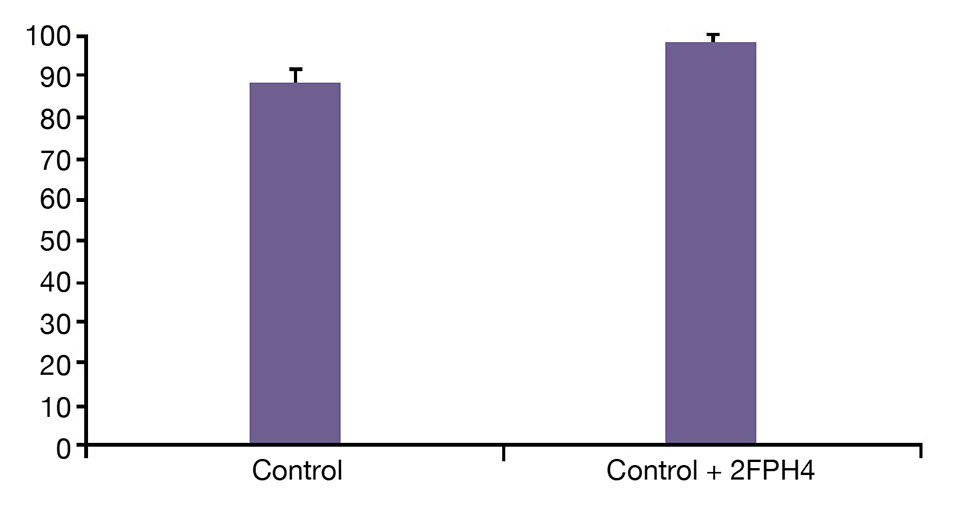
At this macroscopic scale, it is difficult to discuss how FPH has improved fish resistance to opportunistic pathogens. We may, however, propose two patterns.
Thanks to its bioactive functionalities (mostly antistress and immunostimulant), FPH may have improved overall fish health before and/or during the challenge trial. Secondly, FPH may have been a natural source of antimicrobial peptides, which may have been effective against A. hydrophila. Biochemical studies would be necessary to confirm these assumptions.
Perspectives
Despite continuously improved aquaculture practices, stressful events will remain inherent to husbandry due to both climatic hazards and human operations. Fish protein hydrolysates are an excellent nutritional solution to attenuate stressful events’ adverse effects on zootechnical performance. Thanks to their natural high concentrations of low-molecular-weight nitrogen compounds – which include nucleotides, amino acids and derivatives, and bioactive peptides – FPHs act directly or indirectly on aquatic species’ feed acceptance, feed transformation and innate immune defenses to restore or enhance growth rate and health status.
With their antimicrobial properties, FPHs are a good alternative to preventive antibiotic treatments and other feed additives used as immune stimulants or antioxidative agents. In addition, their bioactive peptides profiles and accompanying physiological effects are driven by hydrolysis process leverages such as type of enzyme, temperature, time schedule and pH.
(Editor’s Note: This article was originally published in the May/June 2012 print edition of the Global Aquaculture Advocate.)
Authors
-
-
V. Fournier
Aquativ
ZA du Gohélis
56250 Elven, France -
M. Hervy
Aquativ
ZA du Gohélis
56250 Elven, France -
A. Ngoc
Aquativ
ZA du Gohélis
56250 Elven, France
Tagged With
Related Posts

Aquafeeds
Algae alternative: Chlorella studied as protein source in tilapia feeds
Chlorella and other species have potential as protein sources in aquafeeds. In trials with tilapia fry raised in a recirculating system, the fish received a fishmeal-based control diet or feeds with portions of the fishmeal replaced by Chlorella.

Health & Welfare
A holistic management approach to EMS
Early Mortality Syndrome has devastated farmed shrimp in Asia and Latin America. With better understanding of the pathogen and the development and improvement of novel strategies, shrimp farmers are now able to better manage the disease.

Aquafeeds
A look at phospholipids in aquafeeds
Phospholipids are the major constituents of cell membranes and are vital to the normal function of every cell and organ. The inclusion of phospholipids in aquafeeds ensures increased growth, better survival and stress resistance, and prevention of skeletal deformities of larval and juvenile stages of fish and shellfish species.

Aquafeeds
A look at protease enzymes in crustacean nutrition
Food digestion involves digestive enzymes to break down polymeric macromolecules and facilitate nutrient absorption. Enzyme supplementation in aquafeeds is a major alternative to improve feed quality and nutrient digestibility, gut health, compensate digestive enzymes when needed, and may also improve immune responses.


